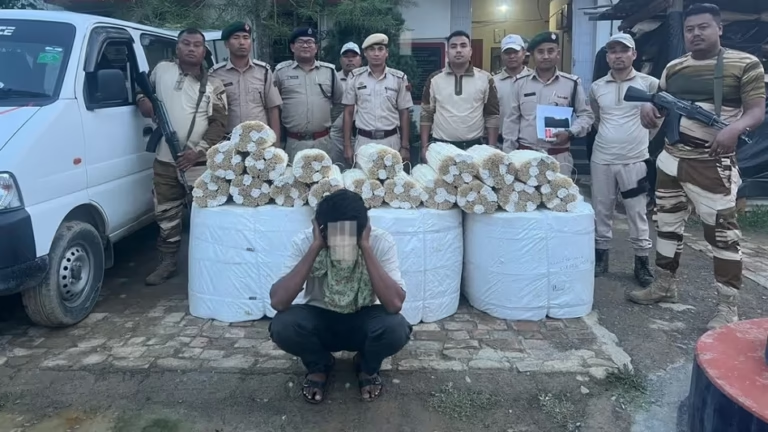Crucial Manipur Peace Meeting Attended by 20 MLAs: Key Insights and What It Means for the Future
Summary of the News Article
A crucial peace meeting was held in Manipur on October 15, 2024, attended by 20 MLAs, including six Kuki-Zo MLAs, aiming to bring stability to the conflict-ridden state. The meeting focused on addressing the ongoing ethnic tensions between the Kuki and Meitei communities and finding resolutions to end the violence. The presence of Kuki-Zo MLAs in the meeting was significant, as it marked a potential shift towards reconciliation after months of unrest. This session sought to open dialogue and build trust among various factions, fostering hope for a peaceful resolution in the region.
A Deep Dive into Manipur’s Ongoing Conflict and the Road to Peace
1. Introduction: Manipur’s Struggle for Peace
Manipur, a state nestled in India’s northeastern region, has been in the spotlight due to its ongoing ethnic clashes between the Meitei and Kuki communities. The conflict, driven by deep-rooted tensions, has left a trail of violence and uncertainty in its wake. But on October 15, 2024, a crucial peace meeting, attended by 20 MLAs including six Kuki-Zo MLAs, was held, marking a significant step towards resolving the unrest.
The million-dollar question is: will this meeting change anything? Can Manipur finally find peace, or is this just another futile attempt to settle deep-seated animosity? Let’s dive into the complexities of this situation and explore the potential outcomes of this landmark session.
2. The Ethnic Conflict: A Brief Background
Before we get into the meeting itself, it’s important to understand the root cause of the conflict. Manipur is home to diverse ethnic communities, with the Meitei and Kuki being the major groups involved in the current unrest. The Meiteis primarily reside in the valley regions, while the Kukis are mainly concentrated in the hill areas. Historically, both communities have had tensions over land, political autonomy, and ethnic identity.
In recent years, these tensions have escalated into full-blown violence, leading to loss of lives, displacement of thousands, and a fractured society. It’s like living in a house where the foundation has deep cracks—unless those cracks are addressed, the entire structure remains vulnerable.
3. The Importance of the Peace Meeting
The peace meeting held on October 15, 2024, is more than just another political gathering; it represents a significant opportunity for dialogue. The fact that 20 MLAs, including six Kuki-Zo representatives, participated shows that there is a growing desire to mend relations. It’s like gathering family members who have been at odds for years—everyone knows it’s time to reconcile, but the path to doing so is never easy.
The key focus of the meeting was to create an environment of mutual respect and understanding. Both sides are weary of the violence, and there’s a growing realization that peace can only come through dialogue and compromise. But can this one meeting really set the tone for lasting peace?
4. Challenges Facing the Peace Process
While the meeting is a positive step forward, several challenges stand in the way of true reconciliation. Trust, or rather the lack of it, is the biggest barrier. The Kuki and Meitei communities have been deeply divided for so long that it will take more than just one meeting to heal the wounds.
Another issue is the political landscape of Manipur. Power dynamics, land rights, and autonomy are sensitive topics that both sides are reluctant to concede on. It’s like trying to share a pie where everyone wants the biggest slice—negotiations are bound to be complex and fraught with tension.
Furthermore, external influences such as insurgent groups and vested political interests could derail the peace process. These groups often have their own agendas and may not want peace to prevail if it threatens their hold on power.
5. The Role of the Central Government and Security Forces
The central government has a critical role to play in the peace process. In recent years, it has deployed paramilitary forces to contain the violence, but military intervention alone cannot bring about lasting peace. The government must act as a neutral mediator, ensuring that both communities are fairly represented in negotiations. Think of it like refereeing a high-stakes game—impartiality is key to making sure the rules are followed and everyone plays fair.
The security forces also have a dual role: they need to maintain law and order while also ensuring that they do not aggravate the situation. In conflict zones like Manipur, even the slightest misstep can lead to more violence.
6. The Kuki-Zo MLAs: Why Their Participation Matters
The involvement of six Kuki-Zo MLAs in the peace meeting is a significant development. For months, the Kuki community has felt marginalized and underrepresented in the government’s efforts to restore peace. Their participation in this meeting signals a willingness to engage in dialogue and work towards a solution.
Imagine being part of a group that feels sidelined and ignored—finally being invited to the table to voice your concerns is not just empowering; it’s a sign that change might be on the horizon.
7. What’s Next? Steps Toward Long-term Peace
While the peace meeting is a crucial first step, it’s just the beginning of a long road toward reconciliation. Here are some steps that could potentially lead to lasting peace in Manipur:
- Regular Dialogue: One meeting is not enough to resolve deep-rooted issues. Regular dialogue between both communities and political representatives is essential for building trust and understanding.
- Addressing Grievances: The government needs to address the legitimate grievances of both the Kuki and Meitei communities. This includes discussions on land rights, political autonomy, and economic development.
- Involving Civil Society: Peace cannot be achieved solely through political means. Civil society, including community leaders, NGOs, and activists, should be involved in the peace process to ensure that the voices of the common people are heard.
- Rehabilitation and Justice: The victims of violence need justice, and the displaced need to be rehabilitated. Without addressing the aftermath of the conflict, any peace agreement will only be a temporary fix.
- Curbing Insurgent Activity: Insurgent groups that thrive on conflict must be dealt with through negotiations or other means. Their influence poses a significant threat to the peace process.
8. The Human Cost of Conflict: Stories of Suffering and Hope
Behind every conflict are the human stories that often go untold. In Manipur, thousands have been displaced due to the violence, living in makeshift camps with little access to basic amenities. Families have been torn apart, children have lost their homes, and livelihoods have been destroyed.
Yet, amidst the suffering, there is also hope. Many local communities have come together to provide relief to those affected, and peace initiatives led by grassroots organizations have gained momentum. These acts of solidarity show that, even in the darkest of times, the human spirit is resilient.
9. Can Manipur Achieve Lasting Peace?
The question that everyone is asking is: can Manipur achieve lasting peace? The answer is not simple. Achieving peace in a region as complex as Manipur will require sustained efforts from all stakeholders—political leaders, civil society, security forces, and the communities themselves.
It’s like tending to a fragile plant. Peace is delicate and requires constant care. Neglect it, and the violence will return. Nurture it, and it has the potential to grow into something strong and lasting.
10. Conclusion: A Glimmer of Hope
The peace meeting on October 15, 2024, attended by 20 MLAs, including six Kuki-Zo representatives, offers a glimmer of hope for Manipur. While challenges remain, the willingness to engage in dialogue and work towards reconciliation is a positive sign. The road ahead will not be easy, but with sustained efforts and a commitment to inclusivity, Manipur may finally be able to overcome its divisions and build a peaceful future.
FAQs
- What was the purpose of the October 15, 2024, peace meeting in Manipur? The meeting aimed to address the ongoing ethnic conflict between the Meitei and Kuki communities and work towards peace and reconciliation.
- Why was the participation of Kuki-Zo MLAs significant? The participation of Kuki-Zo MLAs marked a willingness from the Kuki community to engage in dialogue, which had previously felt marginalized in the peace process.
- What are the main challenges to achieving peace in Manipur? The main challenges include deep-seated mistrust between the communities, political power dynamics, land rights issues, and insurgent activities.
- How can the central government contribute to the peace process? The central government can act as a neutral mediator, ensure fair representation of both communities in negotiations, and maintain law and order without exacerbating tensions.
- What steps are needed to achieve lasting peace in Manipur? Lasting peace can be achieved through regular dialogue, addressing grievances, involving civil society, ensuring justice and rehabilitation, and curbing insurgent activities.


